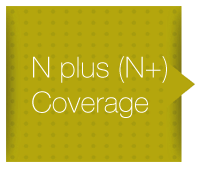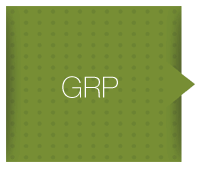Terminology

The coverage or reach of a campaign is the number of individuals in a population who have seen the advertising at least once, sometimes it is expressed as a percentage of the population, sometimes as a direct number. For instance, a campaign could have covered or been seen by 47% of the Adult population or alternatively it may be reported that the campaign reached 250,000 15-24 year old adults.

It will be realised that when a large population has been covered by a medium like posters, some people will have seen the campaign only once, but some will have seen it many times, and frequent travellers many many times. If we calculate the average number of times that the average individual saw the campaign, then we call this the average frequency of the coverage. Hence we now have coverage and frequency.

Simple coverage or 1+ coverage is a measure of all the people who have seen a campaign at least once, so the resulting number includes the people who have seen it only once, but also those who have seen it twice, three times, four times etc. etc. This is why the coverage level is often referred to a 1 plus (1+) as it’s a measure of who has seen the campaign once or more (+).
The cafas system allows the calculation of 1 + to 20 + coverage levels. So for example, if 4+ was chosen, the system would calculate the coverage level of the population who had seen the campaign four or more times. The population who had only seen the campaign once, twice or three times would be removed from the coverage estimate.
One consequence of this is that the average frequency for 4+ is higher than 1+. This is because we have removed the people from the frequency distribution who had only made low numbers of passages. In consequence the average frequency of the remaining coverage will mathematically rise.
It should also be noted that the N+ coverage is visibility adjusted, so that to “see” a campaign four or more times, the number of passages required is many times this, depending on the visibility of the posters in the campaign.

In the roadside environment, this is the total number of passages past an individual site regardless of its visibility, it is a measure of “busyness”. It is calculated as the total vehicular traffic past the site multiplied by an occupancy factor of 1.4, plus the total pedestrian traffic past the site.
In the Cafas system the numbers shown on all screens are “average adult flows per week”. (Av Flow P/W). This allows for direct comparisons between the media owner and size digest pages and the planner and campaign screens regardless of campaign period.
This Av Flow P/W number is describing the average number of “people passages” past the panels in that network or for that size in a region. Note; it is not the average number of “individual people” who pass each panel, because the same person may pass the panel more than once over a period of 7 days. For example, one individual may count as 10 or 14 “people passages” depending on how many times they pass a particular panel in a week.
The total flow or passages for a group of panels is: the average flow per week X the total number of panels.
The average flow per week does not change if the campaign is run for more than 1 week. However the total flow then becomes: the average flow per week X the total number of panels X number of weeks.
The Flow at any particular location is adjusted by month, depending on daylight hours and the posters illumination status. The displayed Flow is for all adults (12-74 yr old) and will not change when a different social group is selected

In the roadside environment, this is the flow at each location adjusted for poster orientation or direction. For instance a “head-on” or perpendicular to the road poster, will only be seen when approaching from one direction and this would mean its OTS would be a half of the total road traffic flow. Whereas, a parallel poster can be seen when approaching from both directions and would be allocated the total flow for the road.
This Av OTS P/W number is describing the average number of adult passages (15+) past the panels in that network or for that size in a region that result in a potential opportunity to contact the poster.
In the Cafas system the numbers shown on all screens are “average adult OTS per week”. (Av OTS P/W). This allows for direct comparisons between the media owner and size digest pages and the planner and campaign screens regardless of campaign period. The total OTS for a group of panels is: the average OTS per week X the total number of panels.
The average adult OTS per week does not change if the campaign is run for more than 1 week as its is a “per week” (PW) value. However the total OTS then becomes: the average OTS per week X the total number of panels X number of weeks.
The OTS at any particular location is adjusted by month, depending on daylight hours and the posters illumination status. The displayed Av OTS PW is for all adults (15+) and will not change when a different social group is selected.

The visibility adjusted contact for any poster is the OTS reduced using the probability based visibility model.
For roadside posters this model is dependent on the posters physical characteristics, the size, the location relative to the road, the viewing distance and the local traffic speed.
This Av VAC P/W number is describing the average number of adult eyes-on-panel “contacts” for the panels in that network or for that size in a region. In the Cafas system the numbers shown on all screens are “average VAC per week”. (Av VAC P/W). This allows for direct comparisons between the media owner and size digest pages and the planner and campaign screens regardless of campaign
period.
The total visibility adjusted contacts (VAC) for a group of panels is: the average VAC per week X the total number of panels.
The average VAC per week does not change if the campaign is run for more than 1 week. However the total VAC then becomes: the average VAC per week X the total number of panels X number of weeks.
The VAC at any particular site is adjusted by month, depending on daylight hours and the posters illumination status so the average VAC for a group of posters will change month by month depending on daylight hours. The displayed Av VAC PW is for all adults (15+) and will not change when a different social group is selected. The total Visibility adjusted contacts (VA contacts) changes by social group.

Is the estimated percentage proportion of the selected audience by region that will have at least one eyes-on panel contact with the campaign of N panels over the time period selected. The displayed VAC coverage will change when a new social group is selected. It is displayed in column (VAC cover%)

Is the VAC cover translated to the number of the selected social group in that region, that will have at least one contact with the campaign. (VAC cover% X Total region social group population = POP cover) For example if there are 1,000,000 males in a region, and you have a VAC cover of 56% then you will have covered 560,000 males. It is displayed in column (POP Cover)

Is the total number of “eyes-on-poster” contacts generated by the campaign over the selected number of days for the selected social group. It is a mathematical calculation being the total VAC per week of each poster X the number of weeks X the proportion of contacts made by the social group. In the planner it is the Av VAC P/W X the number of posters X the number of weeks.

Is the average number of visibility adjusted contacts (VAC) that the covered population (selected social group) will have with the campaign over the selected number of days, 7 or 14 or 21 etc. It is a mathematical calculation being the total Visibility adjusted contacts divided by the number of people covered.
For example if the campaign covers 1,000,000 adults and there are 13,500,000 Visibility adjusted contacts, then the average number of contacts per person is 13.5. It is displayed in column (VA Av Freq)

GRP (Gross Rating Points) is a measure of the total number of “contacts” that a campaign has achieved, basically the percentage of the population X (times) the average number of times this population have seen the campaign. In each medium it is calculated the same way, but has slightly different meanings.
In TV, when a buyer buys a spot, each spot achieves an audience. This is called it’s ‘rating’ ‘TVR’ or ‘GRP’.
If an example spot has a GRP of 10, then this means that the spot has reached 10% of the universe (freq=1). So if the universe is 4,000,000 the ‘impacts’ are 10% of that i.e. 400,000. There is nothing different here from how we handle this calculation in Posters. However, the TV community add up the GRP’s achieved across all of the OTS to give a ‘total GRP’. This could be for example 200 GRP’s.
This means that the impacts are the equivalent of 2 X the universe i.e. 8,000,000. Of course this does not give any indication of frequency distribution. For this you have to refer to the TV research panel i.e. the equivalent of the OUTDOOR IMPACT travel survey sample. Of course some people will see the spot just once, some twice etc. In effect, the individual audiences to each spot will and must add up to the sum of the frequency distribution. So total GRP’s can be calculated in many ways e.g.
For example:
1. Total impacts / universe X 100
2. Addition of individual spot (or panel) GRP’s
3. Average frequency X coverage X 100 (e.g. 4.5 X 90% X 100 = 405 GRP’s)
4. % audience seeing it once X 1 – plus % audience seeing it twice X 2 – plus % of audience seeing it three times X 3 etc.
Total GRP’s, coverage and frequency plus total frequency are often shown as part of the campaign results. The above definitions are used in all media. Exceptions are TV where GRP’s are called TVR’s or ‘ratings’ and Radio where OTS is called OTH (opportunity to hear).

In advertising terms, the share of voice is the proportion of the available media or time that will be bought for the particular campaign. For example, if two beer manufacturers were launching a new beer at the same time, then they would want to have at least an equal “share of voice” so that their own advertising message was not overwhelmed by the other manufactures advertising. In posters, if we select a certain size, for example bus-stop posters, then the share of voice is the proportion of available posters in a region. If there were 1000 posters in a region, then 200 posters would be a 20% “share of voice”. The cafas calculated share of voice is for size and environment and is not media owner sensitive. For example if we are planning 6 sheet roadside and choose
distribute by share of voice, the system calculates the percentage of all roadside 6 sheets by region.

The Flow/OTS and VAC within the research system are sensitive to time of year, daylight hours and hence illumination of the panels. A panel is only counted as having illumination if and only if there is a directly builton illumination device. This can be a back-light or a top or bottom spot light.

The coverage of a network is not only dependent on the size and quality of the posters within the campaign, but also on how well the posters are spread through a modelled region. The cafas system calculates a measure of distribution and adjusts the final VAC coverage to correlate with this. For example, if we were to have 100 posters spread evenly across Vilnius, they would achieve higher measured coverage than if 100 equal quality posters were just spread across the western part of Vilnius.

